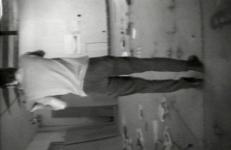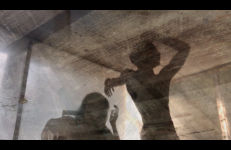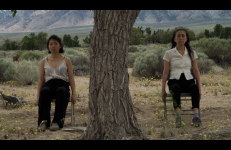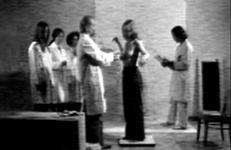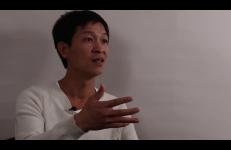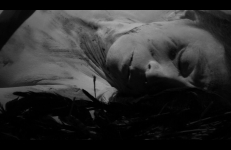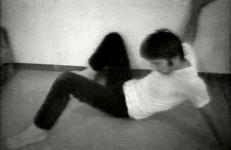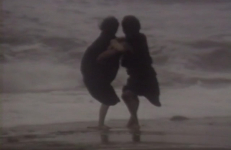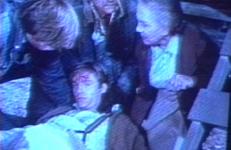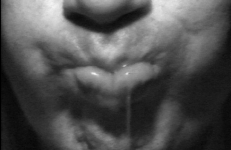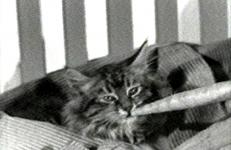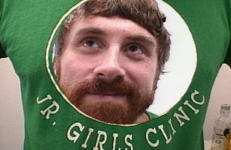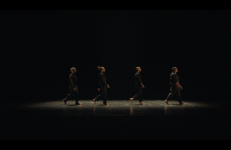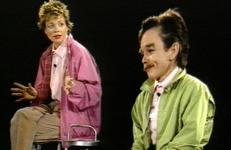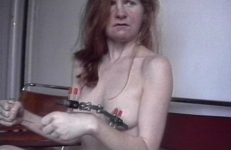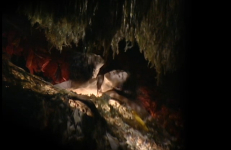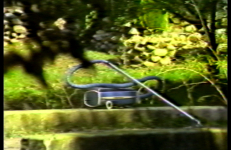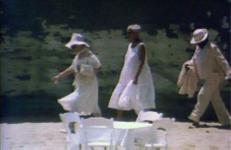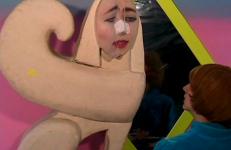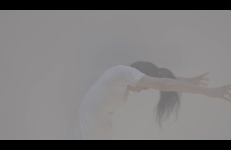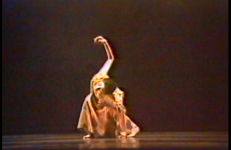Nauman stands with his back to the camera, repeatetedly drawing the bow across the strings of a violin tuned D, E, A, D. Perhaps more than any other exercise, this tape demonstrates the sense of anticipation built up in the viewer, as we wait for Nauman to walk, to turn around, to play music ... to do something. This title was in the original Castelli-Sonnabend video art collection.
Performance
A collaboration with DonChristian Jones.
Filmed during the Rauschenberg Foundation Residency November 2017.
On April 30, 2019, Eiko and Alexis Moh, one of Eiko's collaborators in The Duet Project, visited the Manzanar Historical Site. Manzanar was one of ten American internment camps where over 110,000 Japanese Americans were incarcerated during the World War II. At the peak (in September 1942), 10,046 Japanese Americans were forced to live in Manzanar.
This video was shot two days after Manzanar Pilgrimage commemorated its 50th anniversary on site.
Taking aim at the social standardization enforced particularly on women's bodies, Rosler critiques the politics of "objective" or scientific evaluation that result in the depersonalization, objectification, and colonization of women and Others. As Joseph Di Mattia has pointed out, "The title of the tape is ironic--just exactly to whom are these 'statistics' 'vital'?
Electronic musician and sound artist Stephen Vitiello (b.1964) creates sonic installations that function to give a physical form or space to audio. In this interview, Vitiello discusses his beginnings as a film student, and his transition from music to fine art through his investment in storytelling aspects of soundtracks. As a teacher, artist, and long-time curator at Electronic Arts Intermix, Vitiello’s insights and anecdotes offer up sentimental reflection and hard-learned life lessons, as well as perspective on the historic landscape of music and art in the 1980s and 90s. By discussing his partnerships with Tony Oursler, Jem Cohen, and Nam June Paik, Vitello provides entry into the myriad influences and collaborations that have shaped his working process and artistic career.
Danh Vo is a Vietnamese-born Danish conceptual artist, currently living and working between Berlin and Mexico City. His large installations often deal with issues of personal identity and belonging. In conversation with Norah Taylor, an art historian specializing in South and Southeast Asian art, Vo discusses his upbringing, career, and what led him to become an artist.
Wake is a cinematic dance collaboratively created by Eiko & Koma and James Byrne. It was filmed in special sessions during the premiere run of the living installation Naked, at Walker Art Center, November 2-30, 2010. James's body held camera moves with Eiko & Koma through a primal landscapes.
Making himself into a “minimalist” prop sculpture in the manner of Richard Serra, Nauman moves through various poses in realtion to the floor and wall. While other sculptors were using wood planks, pieces of lead, or sheets of steel, Nauman uses his body to explore the space of the room, turning it into a sort of yardstick to investigate and measure the dimensions of the space. This title was in the original Castelli-Sonnabend video art collection.
Adapted from their performance work Fur Seal (1977), this video is the first and only outdoor work Eiko & Koma created for video. The piece was filmed at Pt. Reyes, California in November 1983. Eiko & Koma were very cold because of the water and wind–so were the film crew! Eiko edited the piece with the help of Jeff Bush.
This work was originally designed with no sound and was 19 minutes long but in this shorter version, Eiko added the sound of sea waves.
A deft and cunning re-examination of John Boy’s near-death experience at the sawmill. A homespun midnight deconstruction of an entire era of television mannerisms.
“One of the strengths of The Waltons, a video that records a session of TV viewing using a handheld camera, is its ability to convey how our surroundings inform our experience. The video doesn’t stray far from the images on the TV screen, but our attention is divided between the show’s action and the off-camera activity in the apartment.”
Acconci explodes the notion of an artist’s creation, his creative act being the build-up and discharge of saliva, an activity more properly belonging to the realm of necessary and autonomic bodily functions than art. Positioning himself as a hyper self-conscious artistic subject, Acconci fuses the terrains of body art and process art, formulating the body as process, and art as a natural function of the body.
This title was in the original Castelli-Sonnabend video art collection.
“A spoof on current art attitudes [that] stretches the definition of what can be considered art. Because the late 1960s and early 1970s were periods of innovation, using the human body as art, making process equivalent to product... [etc.], Baldessari questions that very sense of originality and exploration by taking it to its (rather mundane) limits. By taping a stick at one end, then picking it up at the other, he is both questioning and spoofing what constitutes art.” —Marcia Tucker, “John Baldessari: Pursuing the Unpredictable,” John Baldessari (New York: New Museum, 1981)
I wander around empty halls of academic buildings carrying bags of Halloween atrocities for our latest class project: a horror movie that lives up to that classification on multiple levels. The viewer is given a front row seat to the directorial process as young and nubile film students submit to attacks by rubber props in a Frankenstein thriller big on chills (caused mainly by the lack of budget) and low on underwear paraphernalia.
Weaving Stories While Walking, a reading-performance film by Sónia Vaz Borges and Mónica de Miranda, interweaves multiple accounts from members of the resistance against the colonial powers in Cabo Verde, Guiné-Bissau, Angola, and Portugal. It looks at the centrality of individual and collective walking, movement, and affective experiences in understanding the liberation struggles and their legacy in the contemporary times. Weaving Stories While Walking intermingles timely narratives for the current social contexts.
Weaving Stories While Walking, a reading-performance film by Sónia Vaz Borges and Mónica de Miranda, interweaves multiple accounts from members of the resistance against the colonial powers in Cabo Verde, Guiné-Bissau, Angola, and Portugal. It looks at the centrality of individual and collective walking, movement, and affective experiences in understanding the liberation struggles and their legacy in the contemporary times. Weaving Stories While Walking intermingles timely narratives for the current social contexts.
Shot with my students at the San Francisco Art Institute, this colorful drama with song and dance numbers (plus burlesque acts) follows the libidinous poisoning of Vatican personnel by an otherworldly intruder. The cast is mostly young and vibrant and the songs staged as opulently as possible on a $400 budget. Anyone interested in these collaborative productions will find a lot to gawk at in this backstage romance with pagan overtures galore.
An experimental video for electro-feminist-performance-artists Le Tigre, the early eighties MTV aesthetic unpacks a thoroughly current obsession: the hidden erotics of office supplies.
This title is also available on Elisabeth Subrin Videoworks.
Strapped for time due to her busy schedule of personal appearances, Anderson creates a rather clumsy looking clone to take over and keep up her artistic production. Anderson plays both parts, pitting the chain-smoking, productive male half against the laid-back female half. In the end, one highly successful clone begets another clone, a situation spoofing the rise and fall of the '80s art star.
A performance about the artist’s experience in the aftermath of an accident.
Commissioned by and performed at the 2000 Brooklyn Academy Music Next Wave Festival, When Nights Were Dark is a full evening-length collaboration with Joseph Jennings and the Praise Choir. The work was created during a Lower Manhattan Cultural Council residency which allowed Eiko & Koma the full time use of the studio on the 91st floor of the World Trade Center North Tower throughout 2000. The décor of The Caravan Project was hugely expanded for this work and placed on a slowly turning wheel.
Using the first color video camera, the artist questions where the devil might be hiding, and then takes a nighttime swim.
In today’s youth-oriented society, the experience and knowledge of older women is typically unheralded and neglected. Countering these ideas is Suzanne Lacy’s Whisper, The Waves, The Wind—a performance evoking and reinforcing the strong spiritual and physical beauty of older women. Lacy says, “They reminded me of the place where the ocean meets shoreline. Their bodies were growing older, wrinkled. But what I saw was the rock in them; solid, with the presence of the years washing over them.” This tape is a document of that performance.
In this episode of the Whispering Pines series, Moulton's character Cynthia is confronted with a distorted mirror image that slips between the grotesque and the exotic, depending on her posture.
Filmed by Jingqiu Guan on November 7, 2022 at Royce Hall Rehearsal Room during the creative residency sponsored by UCLA Center for the Art of Performance (CAP). This video was used for the performance on November 20, 2022 at UCLA.
Performed by Eiko Otake
Edited by Eiko Otake, assisted by Jingqiu Guan
Eiko & Koma titled all of their performances in Europe White Dance (1972-1974). Their presentations were always about one hour, performed without an intermission. In naming their program White Dance, Eiko and Koma were trying to create a new beginning for themselves, not bound to the butoh works of their teachers Hijikata and Ohno, which were often described by the artists themselves as “dances of darkness.”




